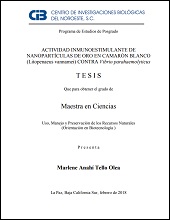Actividad inmunoestimulante de nanopartículas de oro en camarón blanco (Litopenaeus vannamei) contra Vibrio parahaemolyticus
Author
MARLENE ANAHI TELLO OLEA
Metadata
Show full item recordAbstract
"Litopenaeus vannamei (camarón blanco) es una de las especies de crustáceos más cultivadas en acuicultura. Recientemente las cepas de Vibrio parahaemolyticus asociadas a la Enfermedad de la Necrosis Aguda del Hepatopáncreas han causado pérdidas económicas importantes en esta industria. Una de las estrategias para combatir esta enfermedad incluye la administración de inmunoestimulantes. En este sentido la nanotecnología presenta diversas aplicaciones en este campo debido a que las nanopartículas (partículas de 0-100 µm) tienen un gran potencial por las propiedades derivadas de sus dimensiones, que incluyen la capacidad de activar componentes del sistema inmune. En particular, tanto estudios in-vivo como in-vitro en ratones han probado la capacidad de las nanopartículas de oro (AuNPs) para modular el sistema inmune. El objetivo de esta investigación fue evaluar la capacidad inmunoestimulante e inmunoprotectora de AuNPs administradas oralmente en camarón frente a una infección experimental con V. parahaemolyticus. Las AuNPs se caracterizaron morfo-fisicoquímicamente mediante Espectrofotometría Ultravioleta Visible, Microscopia Electrónica de Transmisión, Dispersión de luz dinámica (DLS) y Potencial Z. Las AuNPs se administraron vía oral (dosis única) evaluando 3 niveles de dosis (0,2; 2 y 20 µg de AuNPs por gramo de alimento) tomando muestras cada 24h por 6 días. Se evaluó la supervivencia, daños a tejidos mediante histología, conteo de hemocitos totales, actividad superóxido dismutasa, catalasa y peroxidasa. Se analizó la expresión a nivel transcripcional del receptor tipo Toll-3 y profenoloxidasa (proPO), genes relacionados a la función inmune en hemocitos e intestino. Las AuNPs empleadas tuvieron un tamaño promedio de 18.57 ± 4.37 nm, se encuentran medianamente dispersas y con un potencial negativo de -10.3 ± 0.208 (pH=7). No se encontraron signos histológicos de toxicidad o daño al tejido en ninguna de las dosis probadas. Se observó una inmunoestimulación temprana a nivel sistémico en términos de la expresión del receptor tipo Toll-3 y de proPO para hemocitos; así como de Toll-3 en intestino; lo que sugiere que las nanopartículas de oro son seguras y capaces de inmunoestimular a nivel temprano. La dosis media de AuNPs indujo una disminución del daño histopatológico respecto al control positivo y una supervivencia del 80% en los organismos retados con V.parahaemolyticus-AHPND..." "Litopenaeus vannamei (white shrimp) is one of the most cultivated crustacean species in aquaculture. Recently, the Vibrio parahaemolyticus strains associated to the Acute Hepatopancreatic Necrotic Disease have caused significant economic losses in this industry. One of the strategies to fight this disease relies in using immunostimulants. In this sense, nanotechnology offers several applications in this field due to the fact that nanoparticles (particles of 0-100 μm) have great potential for the properties derived from their dimensions, which include capacity to activate immune system components. According to in vivo and in vitro studies in mice have tested the ability of gold nanoparticles (AuNPs) to modulate the immune system. This study aimed to evaluate the immunostimulant and immunoprotective capacity of AuNPs administered orally in shrimp against an experimental infection with V. parahaemolyticus. AuNPs were characterized morpho-physicochemically by Ultraviolet-Visible Spectrophotometry, Transmission Electron Microscopy, Dynamic Light Scattering (DLS) and ζ (Zeta) Potential. AuNPs were administered orally (single dose) evaluating three level doses (0.2, 2 and 20 μg AuNPs per gram of feed), taking samples every 24 hours for 6 days. Survival rate, tissue damage by histology, total hemocyte count, superoxide dismutase, catalase and peroxidase activity were evaluated. Expression of Toll-3 like receptor and prophenoloxidase (proPO) genes related to the immune system in hemocytes and gut was also analyzed. The AuNPs had an average size of 18.57 ± 4.37 nm, are moderately dispersed and with a negative ζ potential of -10.3 ± 0.208 mV, pH=7. No histological signs of toxicity or tissue damage were found in any doses tested. Early immunostimulation was recorded at systemic level in terms of Toll-3 like receptor and proPO expression in hemocytes and Toll-3 expression in gut; suggesting that gold nanoparticles are safe and able to immunostimulate at early level. The group receiving the medium dose of AuNPs induced a decrease in histopathological damage when compared to positive control and a 80% survival rate upon challenge with V. parahaemolyticus-AHPND. The AuNPs are a promising alternative to the control of pathogens in shrimp industry, having implications in the development of strategies to control AHNDP disease."
Collections
Related items
Showing items related by title, author, creator and subject.
-
PROMOCIÓN DEL PERIFITON PARA EL CULTIVO DE CAMARÓN BLANCO: HACIA UNA ACUICULTURA ECOLÓGICA
DOMENICO VOLTOLINA LOBINA; JUAN MANUEL AUDELO NARANJO; MARIA DEL ROSARIO PACHECO MARGES -
Suelo y Erosión
YOLANDA LOURDES MAYA DELGADO


